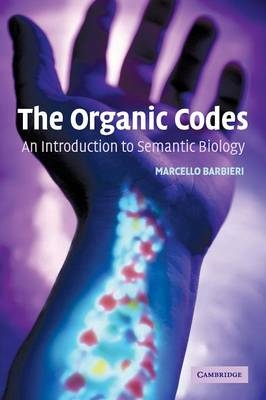
The Organic Codes
An Introduction to Semantic Biology
Seiten
2002
Cambridge University Press (Verlag)
978-0-521-53100-9 (ISBN)
Cambridge University Press (Verlag)
978-0-521-53100-9 (ISBN)
Marcello Barbieri sets out his theory that there are many more organic codes in nature than the genetic code. The existence of these codes can be used to explain the major steps in the evolutionary history of life, and processes like epigenesis and complexity generation in embryos.
The genetic code appeared on Earth with the first cells. The codes of cultural evolution arrived almost four billion years later. These are the only codes that are recognized by modern biology. In this book, however, Marcello Barbieri explains that there are many more organic codes in nature, and their appearance not only took place throughout the history of life but marked the major steps of that history. A code establishes a correspondence between two independent 'worlds', and the codemaker is a third party between those 'worlds'. Therefore the cell can be thought of as a trinity of genotype, phenotype and ribotype. The ancestral ribotypes were the agents which gave rise to the first cells. The book goes on to explain how organic codes and organic memories can be used to shed new light on the problems encountered in cell signalling, epigenesis, embryonic development, and the evolution of language.
The genetic code appeared on Earth with the first cells. The codes of cultural evolution arrived almost four billion years later. These are the only codes that are recognized by modern biology. In this book, however, Marcello Barbieri explains that there are many more organic codes in nature, and their appearance not only took place throughout the history of life but marked the major steps of that history. A code establishes a correspondence between two independent 'worlds', and the codemaker is a third party between those 'worlds'. Therefore the cell can be thought of as a trinity of genotype, phenotype and ribotype. The ancestral ribotypes were the agents which gave rise to the first cells. The book goes on to explain how organic codes and organic memories can be used to shed new light on the problems encountered in cell signalling, epigenesis, embryonic development, and the evolution of language.
Professor Barbieri is based in the Department of Morphology and Embryology at the University of Ferrara, Italy.
Foreword Michael Ghiselin; Dedication; Acknowledgements; Introduction; 1. The microscope and the cell; 2. Theories of evolution; 3. A new model for biology; 4. Organic codes and organic memories; 5. The origin of life; 6. Prokaryotes and eukaryotes; 7. The Cambrian explosion; 8. Semantic biology; 9. A brief summary; Appendix I. Definitions of life; Afterword Jack Cohen; Bibliography; Index.
| Erscheint lt. Verlag | 23.12.2002 |
|---|---|
| Zusatzinfo | 1 Halftones, unspecified; 46 Line drawings, unspecified |
| Verlagsort | Cambridge |
| Sprache | englisch |
| Maße | 152 x 229 mm |
| Gewicht | 430 g |
| Themenwelt | Studium ► 1. Studienabschnitt (Vorklinik) ► Histologie / Embryologie |
| Naturwissenschaften ► Biologie ► Evolution | |
| Naturwissenschaften ► Biologie ► Genetik / Molekularbiologie | |
| Naturwissenschaften ► Biologie ► Zellbiologie | |
| Naturwissenschaften ► Geowissenschaften ► Mineralogie / Paläontologie | |
| ISBN-10 | 0-521-53100-4 / 0521531004 |
| ISBN-13 | 978-0-521-53100-9 / 9780521531009 |
| Zustand | Neuware |
| Haben Sie eine Frage zum Produkt? |
Mehr entdecken
aus dem Bereich
aus dem Bereich
Zytologie, Histologie und mikroskopische Anatomie
Buch | Hardcover (2022)
Urban & Fischer in Elsevier (Verlag)
CHF 75,60
Gewebelehre, Organlehre
Buch | Spiralbindung (2024)
Urban & Fischer in Elsevier (Verlag)
CHF 34,95


